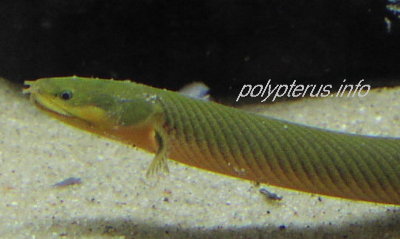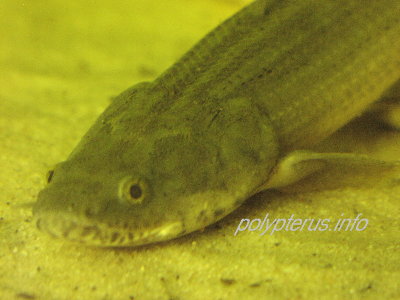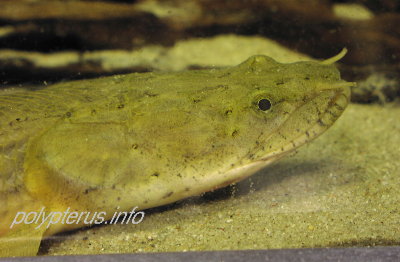| Cyphotilapia frontosa |
 Frontosa are characterized by a white (or blue) body, adorned with either 6 or 7 black, vertical bars. Adults develop a large cephalic hump, with that of males usually being more pronounced. The hump is a large fatty deposit that rests atop a dorsal muscle that tends to extend forward. The hump develops and increases in size with age and is usually a sign of sexual fecundity. Their fins become more elaborate with age as well. There is nothing quite like the sight of a 10-year old frontosa with his long fins waving gracefully below and behind him.
Frontosa are characterized by a white (or blue) body, adorned with either 6 or 7 black, vertical bars. Adults develop a large cephalic hump, with that of males usually being more pronounced. The hump is a large fatty deposit that rests atop a dorsal muscle that tends to extend forward. The hump develops and increases in size with age and is usually a sign of sexual fecundity. Their fins become more elaborate with age as well. There is nothing quite like the sight of a 10-year old frontosa with his long fins waving gracefully below and behind him.Frontosa are found in many different locations in the lake, but always in the deeper portions along the coastline - 10-50 m (30-170 ft). Like many sedentary animals (e.g., tortoise), Fronts have an unusually long life span of over 25 years. This sedentary behavior has probably been the impetus for the development of several geographic variants. The ones pictured on this page are all from Burundi. Other geographical races come from Kigoma, Bulu Point, Mpimbwe, Samazi, Kasanga, Chaitika, Kapampa, Kavala, and Zaire. For a detailed description of their differences, visit the Frontosa Variant Map. Many other varieties exist, but for now they are considered to be junior races of the ones listed above and documented on the Frontosa Variant Map.
Cyphotilapia frontosa is a monomorphic species with little or no difference between males and females. Males usually have a larger hump than females, but this characteristic is by no means a garauntee. Frontosa can only be sexed reliably by venting, and even this method cannot always be trusted. Venting frontosa accurately requires experience. Males also tend to be larger - they can grow to over 12 inches while females are lucky to reach 10 inches - but this too is not always true. In short, be cautious of any one ready to sell you sexed frontosa; make sure they're experienced and reputable.
As already mentioned, C. frontosa is a lethargic and slow-moving fish. Even in the lake they don't expend much energy in hunting down their food. Nature has endowed them with a unique trait which gives them an advantage over their prey - Fronts are nocturnal feeders and don't require much light to wake up.
 Fish make up the majority of their diet, Cyprichromis species being their primary target. Cyps spend the day in large schools (numbering in tens of thousands) in the upper water column, but at dusk, they descend to the bottom where they hug the substratum. Fronts, still awake and alert, easily scoop the unsuspecting Cyps up by the mouthful. Because of the ease with which they are able to feast upon the Cyps, frontosa don't have to spend much energy chasing their food, a chase they would certainly lose to the agile Cyps during the day.
Fish make up the majority of their diet, Cyprichromis species being their primary target. Cyps spend the day in large schools (numbering in tens of thousands) in the upper water column, but at dusk, they descend to the bottom where they hug the substratum. Fronts, still awake and alert, easily scoop the unsuspecting Cyps up by the mouthful. Because of the ease with which they are able to feast upon the Cyps, frontosa don't have to spend much energy chasing their food, a chase they would certainly lose to the agile Cyps during the day.In the tank, this cichlid can be fed small feeder fish (live or frozen), mysis, shrimp, krill, and worms. Pellets are also a good food, but flakes should be avoided after they reach 4 or 5 inches in total length. Flakes will either go ignored or get too messy and are not adequate to bring them into breeding condition.
In the wild, frontosa live in large groups called colonies. In the aquarium, they should also be kept in larger groups, although they can be kept successfully in groups as small as four individuals (1 male:3 females). You'll have the best luck keeping only one adult male, and if your colony is larger, a second, subdominant male who will eventually replace the alpha-male. If you're growing your Fronts up, the "best" method is to acquire 12-15 individuals (all unrelated and from the same race) and put them in a tank of their own.
Of these 12 or 15 fry, half will probably be female. It will be a solid three or four years before they will reach sexual maturity, so we have time on our hands, and what we want to do with this time is weed out the males. As time progresses, the largest of the group will be a male. Sell this male off.
 In another six months' time, do this again, selling or trading the largest Front. Repeat this practice every six months or so until you are left with five or six Fronts. By now, all your males should be gone. You can verify this by venting them (i.e., checking their tubes). After three to four years time, they'll be ready to start spawning. When they are, buy yourself a beautiful, adult male and make him your stud. It is not hard to find large, healthy adults. Wild-caught males are usually available as well, at reasonable prices. The reason for doing this is to ensure that your male is of different stock than your females, which will help to ensure good fry with fewer deformities. This is important if you plan to sell your fry.
In another six months' time, do this again, selling or trading the largest Front. Repeat this practice every six months or so until you are left with five or six Fronts. By now, all your males should be gone. You can verify this by venting them (i.e., checking their tubes). After three to four years time, they'll be ready to start spawning. When they are, buy yourself a beautiful, adult male and make him your stud. It is not hard to find large, healthy adults. Wild-caught males are usually available as well, at reasonable prices. The reason for doing this is to ensure that your male is of different stock than your females, which will help to ensure good fry with fewer deformities. This is important if you plan to sell your fry.The tank should be decorated simply with a few rocks, which are important to give these shy cichlids a sense of security. Don't overdo it with lots of rocks or sharp rocks. These fish move slow until they get spooked - then they are lightning fast and very clumsy. The alpha-male will be your largest and oddly enough, shyest of the group. He will need a cave, but the females do alright in the open. While not always a success aethestically, clay pots can be used to create caves. Lace rock works well as does slate if placed on its side to create alleys and secretive coves. 40 gallons will work well as a grow-out tank. For a colony of 10 adults, a 125-gallon tank or bigger is recommended.
Patience is necessary if you plan to breed this wonderful fish. Three to four years are required for a 1-inch fish to reach sexual maturity. Sexually active males turn
 blue, especially the snout region. He will select an open, yet secluded area which is only weakly defended. When he has a willing female's attention, he will slowly pass over the spot with his fins folded. Spawning is very inconspicuous - no shaking, no flashing of fins, or sparring with conspecifics. As the male passes over the selected spot, he releases his milt, showing the female where to go. Some have hypothesized that the milt may serve to encourage the female to lay her eggs. She will then pass over the spot in the same manner as the male, slowly and with fins folded. After dropping an egg, she will back up - not turn around - to pick it up. She will repeat this procedure, "rocking back and forth" four to six times. Apparently, the male's milt is powerful enough to fertilize eggs several minutes after it is released.
blue, especially the snout region. He will select an open, yet secluded area which is only weakly defended. When he has a willing female's attention, he will slowly pass over the spot with his fins folded. Spawning is very inconspicuous - no shaking, no flashing of fins, or sparring with conspecifics. As the male passes over the selected spot, he releases his milt, showing the female where to go. Some have hypothesized that the milt may serve to encourage the female to lay her eggs. She will then pass over the spot in the same manner as the male, slowly and with fins folded. After dropping an egg, she will back up - not turn around - to pick it up. She will repeat this procedure, "rocking back and forth" four to six times. Apparently, the male's milt is powerful enough to fertilize eggs several minutes after it is released.Broods number anywhere from 20 to 50 fry, and maybe even as high as 80, depending upon the condition of the female and the variant. Females will hold for a period of 5 weeks. Fry should be separated and raised apart from the adults. Any small fish (under 3 inches) is regarded as food by adult frontosa.









